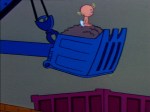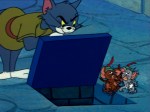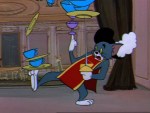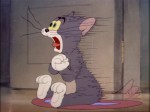You are currently browsing the category archive for the ‘MGM films’ category.
Director: Michael Lah
Release Date: July 4, 1958
Stars: Droopy, Butch (Spike)
Rating: ★★
Review:
 In his last screen appearance, Droopy is a tourist with a few hours in Dublin, Ireland where he buys a leprechaun hat.
In his last screen appearance, Droopy is a tourist with a few hours in Dublin, Ireland where he buys a leprechaun hat.
Then street bum Butch (Spike) thinks Droopy is a real leprechaun, and follows him into (non-existing) Shillelagh Castle to catch him. There Droopy mistakes Spike for the mad duke of Shillelagh Castle. What follows are several appallingly uninspired blackout gags, involving medieval instruments like an iron maiden, a catapult, and a crossbow.
Droopy is completely out of character in this cartoon: he’s no more than a helpless victim of Spike’s fancy, never in control, and constantly fleeing for ‘the mad duke’. Spike, too, has little of himself: he speaks with an Irish accent and has none of the trickster character traits of earlier Droopy films. The result is certainly the least funny Droopy film ever made. As ‘Droopy Leprechaun’ was also the last of the Droopy cartoons, this is a particularly sad farewell to the once so hilarious character.
Watch ‘Droopy Leprechaun’ yourself and tell me what you think:
‘Droopy Leprechaun’ is available on the DVD-set ‘Tex Avery’s Droopy – The Complete Theatrical Collection’
Director: Michael Lah
Release Date: April 4, 1958
Stars: Droopy, Butch (Spike)
Rating: ★★
Review:
 In this Cinemascope cartoon ‘Daredevil Butch’ (Spike) and ‘Buzz Droopy’ race against each other in a car race.
In this Cinemascope cartoon ‘Daredevil Butch’ (Spike) and ‘Buzz Droopy’ race against each other in a car race.
As should be expected, Spike hardly plays fair, and the cartoon consists of several blackout gags in which Spike tries to stop Droopy from racing, including the classic paint-a-tunnel-on-a-wall gag.
The cartoon suffers from a bad sound design (especially Butch’s voice sounds like it was recorded in a toilet) and from an inconsistent story line, which does not build to a climax. Moreover, Lah’s timing is too relaxed for the race theme, and none of the gags really come off. All this unfortunately makes ‘Mutts About Racing’ one of the weakest of all Droopy films. Only the last one, ‘Droopy Leprechaun‘, would be worse…
Watch an excerpt from ‘Mutts About Racing’ yourself and tell me what you think:
‘Mutts About Racing’ is available on the DVD-set ‘Tex Avery’s Droopy – The Complete Theatrical Collection’
Director: Michael Lah
Release Date: February 7, 1958
Stars: Droopy, the Wolf
Rating: ★★★½
Review:
 In ‘Sheep Wrecked’ Droopy is a sheepherder, or more clearly, a sheep dog guarding his flock inside a fenced pasture against the laid-back Southern wolf character ( in his last screen appearance).
In ‘Sheep Wrecked’ Droopy is a sheepherder, or more clearly, a sheep dog guarding his flock inside a fenced pasture against the laid-back Southern wolf character ( in his last screen appearance).
‘Sheep Wrecked’ arguably is the most inspired of Michael Lah’s six Droopy films. The animation is fine, and the gags plentiful. Among the wolf’s attempts are him dressing up like a stork and like Bo-Beep, a gag harking all the way back to the Silly Symphony ‘Three Little Wolves‘ (1936). Both Droopy and the wolf are in fine shape in this cartoon.
Unfortunately, the pace is rather slow, and the best features of this Cinemascope cartoon are Scott Bradley’s very inspired music and F. MonteAlegre’s beautiful backgrounds, with their minimal indications of settings on a bright orange canvas. Remarkably, this Homer Brightman-penned story involves a very slow guided missile, very similar to the one in the Woody Woodpecker cartoon ‘Misguided Missile‘. ‘Misguided Missile’ was penned by the very same writer, and only released eleven days earlier.
Watch ‘Sheep Wrecked’ yourself and tell me what you think:
https://www.dailymotion.com/video/x1y3cwt
‘Sheep Wrecked’ is available on the DVD-set ‘Tex Avery’s Droopy – The Complete Theatrical Collection’
Director: Michael Lah
Release Date: December 6, 1957
Stars: Droopy, Butch (Spike)
Rating: ★★★
Review:
 In this Cinemascope cartoon ‘sir Butchalot’ (Butch a.k.a. Spike) and ‘sir Droopalot’ (Droopy) combat a dragon over a beautiful princess.
In this Cinemascope cartoon ‘sir Butchalot’ (Butch a.k.a. Spike) and ‘sir Droopalot’ (Droopy) combat a dragon over a beautiful princess.
Despite its medieval setting ‘One Droopy Knight’ feels like a remake of ‘Señor Droopy‘ from 1949, as it reuses no less than three gags from the earlier film, including the last one. Unlike the wolf in ‘Señor Droopy’, however, Spike is as unsuccessful as Droopy in combating the dragon, until the very end. The dragon appears quite invincible, indeed, as is demonstrated by Droopy’s feeble attempts to pinch it with his rubbery sword. He’s a well-conceived character on his own, and less a ferocious bully than the bull was in ‘Señor Droopy’. One has the genuine feel he rightly defends himself against those pesky, puny knights.
As in his other cartoons, Michael Lah’s timing is a little too relaxed to make the gags work right. Moreover, the short is hampered by a large amount of dialogue, and even Scott Bradley’s music sounds more canned than before. Several scenes are stolen by the beautiful, highly stylized backgrounds, laid out by Ed Benedict and painted by F. MonteAlegre, with their bright colors and elementary designs.
Watch ‘One Droopy Knight’ yourself and tell me what you think:
https://www.dailymotion.com/video/x1y2den
‘One Droopy Knight’ is available on the DVD-set ‘Tex Avery’s Droopy – The Complete Theatrical Collection’
Director: Rudolf Ising
Release Date: June 22, 1940
Rating: ★★★
Review:
 1940 is arguably a turning year in the history of animation. This year marked the end of Disney’s domination, as the studio’s innovative Silly Symphonies series had stopped, while Disney’s ambitious, but expensive feature productions ‘Pinocchio‘ and ‘Fantasia’ had lost the studio dear money. These features plunged Disney brothers into huge debts, and forced them to go to the stock markets.
1940 is arguably a turning year in the history of animation. This year marked the end of Disney’s domination, as the studio’s innovative Silly Symphonies series had stopped, while Disney’s ambitious, but expensive feature productions ‘Pinocchio‘ and ‘Fantasia’ had lost the studio dear money. These features plunged Disney brothers into huge debts, and forced them to go to the stock markets.
As to emphasize Disney’s loss, 1940 was also the first year in which a non-Disney cartoon won an Academy Award. In fact, in this year not a single Disney cartoon was even nominated. Moreover, among the nominations were two shorts that marked the strong debuts of characters that heralded a new era: Tom & Jerry in ‘Puss and Boots’ and Bugs Bunny in ‘A Wild Hare‘. These characters would dominate the 1940s, over Disney’s Mickey, Donald, Pluto and Goofy.
Yet, it was MGM’s ‘The Milky Way’, which won the Academy Award. To be frank, ‘The Milky Way’ is still firmly rooted in Disney-like 1930’s animation: it’s a Silly Symphony but in name, it features a saccharine song, and it borrows heavily from Disney’s ‘Wynken, Blynken, and Nod‘ (1939). Both cartoons feature three babies exploring the night sky. Such copycat behavior was all too typical for the Harman & Ising studio.
In ‘The Milky Way’ the main protagonists are the three kittens from the nursery rhyme. As they’ve lost their mittens, they aren’t denied pie, but a meal of milk, and sent off to bed without supper. With the help of balloons, the trio sails to the Milky Way, which turns out to be a Cockaigne of milk, with e.g. milk geysers and milk gas stations. However, the geyser milk gives one of the kittens a tremor belly, and soon the trio fall down back to earth.
‘The Milky Way’ is cute, lush and excels in high production values, even though it can’t compete with the stunning ‘Wynken, Blynken and Nod’. The short is also sugary and rather boring. The best part is the depiction of the fantasy world of the Milky Way. But the attention easily goes to the beautiful background art and to Scott Bradley’s excellent score. The designs of the kittens look forward to those of kittens in the Tom & Jerry series.
Watch ‘The Milky Way’ yourself and tell me what you think:
https://www.dailymotion.com/video/x5dyxaa
‘The Milky Way’ is available on the DVD ‘Warner Bros. Home Entertainment Academy Awards Animation Collection: 15 Winners’
Director: Hugh Harman
Release Date: December 9, 1939
Rating: ★★★★
Review:
 ‘Peace on Earth’ is a Christmas cartoon, but a highly unusual one.
‘Peace on Earth’ is a Christmas cartoon, but a highly unusual one.
With ‘Peace on Earth’ Hugh Harman daringly combines the world of cute animals to gloomy and surprisingly realistic images of war and devastation (which, incidentally have more in common with World War I than with World War II).
It’s Christmas time, and the short opens with scenes of a village of squirrels, whose houses are made of helmets. Grandpa squirrel tells his two grandchildren what men were, for they have disappeared from the Earth. His tale is one of war (oddly between meat-eaters and vegetarians) and extermination. This section contains the grimmest war images ever put into an animated cartoon. In Harman’s world cute animals shall inherit the earth, but the film’s message is clear. Released when World War II had been going on for three months, this message came none too soon. Unfortunately, much, much worse was still to come…
‘Peace on Earth’ is a surprisingly daring film for its time, with its clear pacifistic message and dark war imagery – no ordinary feat for a Hollywood cartoon! For today’s standards the animal scenes may be too saccharine, the staging too melodramatic, and the message too obvious, but the war images and the atmosphere of doom make ‘Peace on Earth’ a film that still impresses today. The short was rightfully nominated for an Academy Award.
Watch ‘Peace on Earth’ yourself and tell me what you think:
https://www.dailymotion.com/video/x2ekaww
‘Peace on Earth’ is available on the DVD ‘Warner Bros. Home Entertainment Academy Award-Nominated Animation: Cinema Favorites’
Director: Friz Freleng
Release Date: February 11, 1939
Stars: The Captain and the Kids
Rating: ★★★
Review:
 ‘Mama’s New Hat’ was the last entry of MGM’s ill-conceived ‘Captain and the Kids’ series, which ended prematurely after only fifteen cartoons, lasting only one year.
‘Mama’s New Hat’ was the last entry of MGM’s ill-conceived ‘Captain and the Kids’ series, which ended prematurely after only fifteen cartoons, lasting only one year.
Surprisingly, it’s the series’ best entry, as for once the studio has tried to make a genuine gag cartoon.
The short opens with the two brats buying a new hat for their mother for mother’s day. Unfortunately they ruin it immediately by falling into the mud. So they exchange their muddy hat for one of a neighboring horse. The horse is not pleased, however, and tries to steal the hat back from Ma Katzenjammer. This leads to a long chase scene, making ‘Mama’s New Hat’ one of the earliest entries in a genre that would become standard in the 1940s and 1950s.
The short suffers from inner logic, but it builds up nicely to a grand finale, and it’s surprisingly full of inventive gags, the one in which the horse turns into a plane as a highlight. This is imaginative storytelling at its best.
‘Mama’s New Hat’ still is no masterpiece, but it’s better than all the other ‘Captain and the Kids’ cartoons, and the only one looking forward. It shows that the young studio’s team was capable of more. Friz Freleng, of course, would further prove his worth back at Warner Bros., the others only came into their own with the arrival of MGM stars ‘Tom and Jerry’, who made their debut two years later.
‘Mama’s New Hat’ contains a scene in which we watch a supposed pursuit in a large house from the outside (using a moving pan with a lot of sound effects). This gag was reused much later in the Tom & Jerry short ‘The Flying Cat‘ (1952).
Watch ‘Mama’s New Hat’ yourself and tell me what you think:
http://www.dailymotion.com/video/x1z9pb2
‘Mama’s New Hat’ is available on the DVD-set ‘Looney Tunes Golden Collection Volume Six’
Director: Friz Freleng
Release Date: January 28, 1939
Stars: The Captain and the Kids
Rating: ★
Review:
 In ‘Seal Skinners’ a million dollar seal has escaped and a ten thousand dollar reward has been promised to anyone who can bring him back.
In ‘Seal Skinners’ a million dollar seal has escaped and a ten thousand dollar reward has been promised to anyone who can bring him back.
Somehow, both the captain and the kids, his arch rival Long John Silver and an unknown Eskimo are at the North Pole, waiting for the escaped animal. At one point Long John Silver dresses as a seal himself. When the captain and the kids discover the scam, they roll him into a barrel and shake him like a cocktail. This is arguably the best gag in an otherwise remarkably unfunny cartoon, which ends with no conclusion.
‘Seal Skinners’ features some excellent animation, and Scott Bradley’s score is pretty inspired, but these aspects cannot save the cartoon, which suffers from lack of inner logic, and an absence of appealing characters.
Watch ‘Seal Skinners’ yourself and tell me what you think:
‘Seal Skinners’ is available on the DVD-set ‘Looney Tunes Golden Collection Volume Six’
Director: Friz Freleng
Release Date: December 17, 1938
Stars: The Captain and the Kids
Rating: ★★½
Review:
 ‘The Captain’s Christmas’ is the first of only two ‘Captain and the Kids’ cartoons in color.
‘The Captain’s Christmas’ is the first of only two ‘Captain and the Kids’ cartoons in color.
Color definitely adds some charm to the series, as does the presence of the foe Long John Silver and his three helpers, and the result is one of the better ‘Captain and the Kids’ cartoons.
Watching the captain playing Santa, Long John Silver decides to steal the captain’s act, and, dressed as Santa, descends down the chimney. He plays his part jollily alright, but also very violently, destroying all the kids’ toys. In an all too typical 1930s morale, the villain is reprimanded by his own younger self.
So, Long John Silver thinks up a plan, and with his men goes singing Christmas Carols in a village inexplicably inhabited with Santa Clauses. Silver and his men do their best, but soon the Santas are disgusted by their act, and start throwing toys at the bunch. Thus, the four scoundrels can flood the Captain’s house with toys.
‘The Captain’s Christmas’ is joyous, if nowhere near classic, and full of the Christmas spirit. Unfortunately, its story is rather weird than engaging, and the carol singing sequence just makes no sense. Moreover, none of the songs are really memorable, and one has the feeling that a lot of money and animation talent is wasted on this cartoon, which, after all, remains mediocre.
Watch ‘The Captain’s Christmas’ yourself and tell me what you think:
‘The Captain’s Christmas’ is available on the DVD-set ‘Looney Tunes Golden Collection Volume Six’
Director: Friz Freleng
Release Date: June 25, 1938
Stars: The Captain and the Kids
Rating: ★
Review:
 ‘A Day at the Beach’ features the complete Katzenjammer family frolicking at the beach.
‘A Day at the Beach’ features the complete Katzenjammer family frolicking at the beach.
The film lacks any story, and consists of an unrelated string of repetitive gags whose only reason of existence seems to demonstrate that one can milk a gag to nausea. For example, there’s almost endless footage of the captain battling with a jumpy sun for some shade, and there’s a running ‘gag’ of the ocean destroying grandpa’s der inspector’s sand castle.
Only when Ma almost drowns, the cartoon gains something of a momentum. The film’s best feature, however, is it depiction of drunken sea creatures, a very small highlight in an otherwise endlessly boring film.
Watch ‘A Day at the Beach’ yourself and tell me what you think:
http://www.dailymotion.com/video/xvqhqi
‘A Day at the Beach’ is available on the DVD-set ‘Looney Tunes Golden Collection Volume Six’
Director: Friz Freleng
Release Date: April 16, 1938
Stars: The Captain and the Kids
Rating: ★★
Review:
 In 1937 MGM decided to start its very own studio, after having distributed cartoons by Ub Iwerks (1930-1934) and Harman-Ising. They put Fred Quimby, a producer famous for having neither animation experience nor any sense of humor, in charge.
In 1937 MGM decided to start its very own studio, after having distributed cartoons by Ub Iwerks (1930-1934) and Harman-Ising. They put Fred Quimby, a producer famous for having neither animation experience nor any sense of humor, in charge.
Quimby hired virtually Harman & Ising’s complete staff away. He also hired some talent from other studios, most notably Jack Zander and Joe Barbera, who would later work on Tom & Jerry, and Friz Freleng. Quimby lured Freleng away from Leon Schlesinger by flattery and by offering him a much larger salary. Freleng stayed less than a year at MGM before happily returning to Warner Bros.
Freleng’s talents were wasted on ‘The Captain and the Kids’, a series based on the classic comic strip of the same name by Rudolph Dirks. MGM had bought the rights to this comic strip, and insisted to make a series out of them. The strip had been around since 1897 (first as ‘The Katzenjammer Kids’), and really felt as coming from another era. Amidst the days of Donald Duck, Daffy Duck and Popeye, these characters were hopelessly old-fashioned, and Freleng struggled to create any fun with them. Consequently, none of the Captain and the Kids cartoons have become classics.
Nevertheless, Freleng’s films were still better than that of other people directing the ill-conceived series, which was, in the end, a failure. In total, Freleng directed six Captain and the Kids cartoons, and one stand-alone cartoon called ‘The Bookworm’, before returning to the greener pastures of the Leon Schlesinger studio.
Of Freleng’s Captain and the Kids cartoons, ‘Poultry Pirates’ is the first. It stars the captain, only, who tries to keep a bunch of chickens and ducks out of his vegetable garden, to no avail. At one point he has to fight a six feet tall rooster, but that happens to be part of a dream.
There’s very little to enjoy in ‘Poultry Pirates’. The animators do no attempts to lip synch, neither the captain nor the chicks gain and sympathy, the story drags on, and the result is frustratingly unfunny.
Watch ‘Poultry Pirates’ yourself and tell me what you think:
http://www.dailymotion.com/video/xvqhud
‘Poultry Pirates’ is available on the DVD-set ‘Looney Tunes Golden Collection Volume Six’









